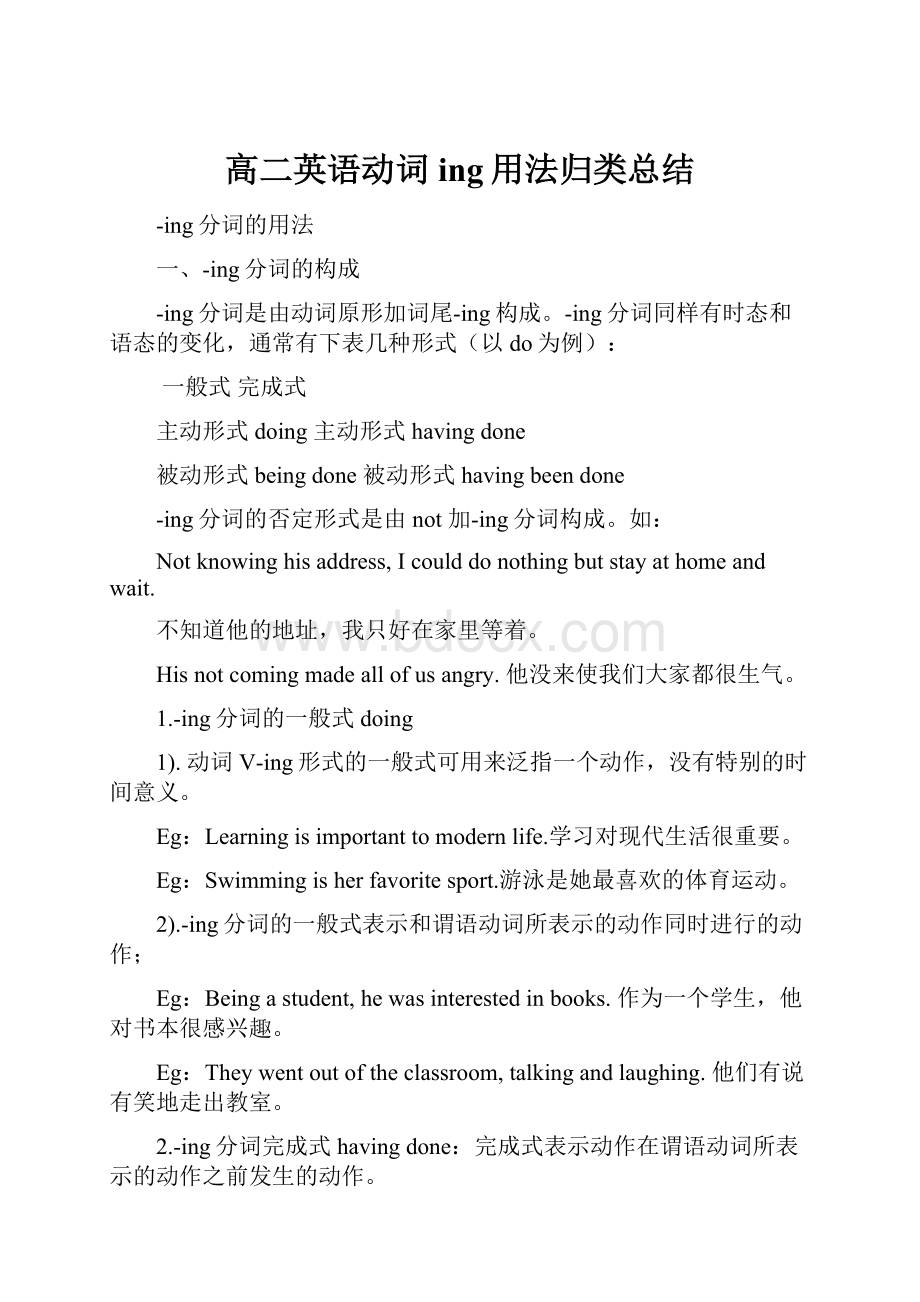高二英语动词ing用法归类总结.docx
《高二英语动词ing用法归类总结.docx》由会员分享,可在线阅读,更多相关《高二英语动词ing用法归类总结.docx(19页珍藏版)》请在冰豆网上搜索。

高二英语动词ing用法归类总结
-ing分词的用法
一、-ing分词的构成
-ing分词是由动词原形加词尾-ing构成。
-ing分词同样有时态和语态的变化,通常有下表几种形式(以do为例):
一般式完成式
主动形式doing主动形式havingdone
被动形式beingdone被动形式havingbeendone
-ing分词的否定形式是由not加-ing分词构成。
如:
Notknowinghisaddress,Icoulddonothingbutstayathomeandwait.
不知道他的地址,我只好在家里等着。
Hisnotcomingmadeallofusangry.他没来使我们大家都很生气。
1.-ing分词的一般式doing
1).动词V-ing形式的一般式可用来泛指一个动作,没有特别的时间意义。
Eg:
Learningisimportanttomodernlife.学习对现代生活很重要。
Eg:
Swimmingisherfavoritesport.游泳是她最喜欢的体育运动。
2).-ing分词的一般式表示和谓语动词所表示的动作同时进行的动作;
Eg:
Beingastudent,hewasinterestedinbooks.作为一个学生,他对书本很感兴趣。
Eg:
Theywentoutoftheclassroom,talkingandlaughing.他们有说有笑地走出教室。
2.-ing分词完成式havingdone:
完成式表示动作在谓语动词所表示的动作之前发生的动作。
Eg:
Nothavingstudiedhislessonsveryhard,hefailedtheexaminations.因为没有努力学习功课,他考试不及格。
Eg:
Havingansweredtheletter,shewentontoreadanEnglishnovel.
Eg:
Havinglivedinthiscityforthreeyears,sheknowsitverywell.
3.-ing分词的被动式beingdone:
-ing分词的被动式表示它的逻辑主语是-ing分词动作的承受者。
被动语态-ing一般式所表示的动作是一个正在进行中的被动动作.
Eg:
Thequestionbeingdiscussedisveryimportant.正在被讨论的问题很重要。
4.havingdone的被动形式havingbeendone表示它的逻辑主语是动词-ing形式表示的动作的承受者。
表示动作在谓语表示的动作之前发生。
Eg:
Havingbeencriticizedbytheteacher,hegaveupsmoking.被老师批评以后,他把烟戒了。
Eg:
Havingbeenshownthelab,weweretakentoseetheschoollibrary.
在被带去看了实验室之后,我们又被带去参观校图书馆。
5动词-ing形式的否定形式 。
动词-ing形式的否定形式通常是在其前加not,带有逻辑主语时not应放在动词-ing形式之前。
Eg:
Excuse me for my not coming on time.
Eg:
I’m sorry for not having kept my promise.
例1. ______ to the station on time made everyone worried last week.
A. Him not getting B. Not his getting
C. His not getting D. Not getting
6.动词-ing形式的复合结构
动词ing形式的复合结构由形容词性物主代词或人称代词宾格,名词所有格或普通格加动名词,动名词的复合结构实际上是给动名词加了一个逻辑主语。
动词-ing形式的复合结构有四种形式:
①形容词性物主代词+动名词
②名词‘s +动名词 ③代词宾格+动名词
④名词+动名词
【注意】动名词的复合结构可在句中作主语或宾语。
作主语时,不能用③④两种形式。
Eg:
Tom’s winning the first prize last year impressed me a lot. 汤姆去年得了一等奖使我印象深刻。
Eg:
Do you mind my/me/Jack’s/Jack leaving now.
翻译练习:
Hiscomingmadeusveryhappy.他的到来使我们大家都很高。
翻译练习:
Hewasawakenedbysomeone’sknockingatthedoor.他被某人的敲门声吵醒了。
二-ing分词的语法作用
动词-ing一方面具有动词的性质,另一方面也相当于一个名词或形容词、副词,在句中可以作主语、表语、宾语、定语、状语和补语等。
1)–ing分词(短语)作主语:
动词ing形式作主语往往表示经常性、习惯性的动作,谓语动词用单数:
Eg:
Readingbookswidensourknowledge.读书增长我们的知识
Eg:
Sayingiseasierthandoing.说比做容易。
翻译练习:
Learning English well is not easy.
在下面两种结构中,-ing分词也作主语。
A.It is no use/no good/useless/worthwhile/dangerous/a waste of time /fun等后需用动名词作真正的主语。
为了保持句子平衡,通常用it作形式主语,而把真实主语放在句末。
Eg:
Itisnousecryingoverspiltmilk.覆水难收
Eg:
It'sawasteoftimearguingaboutit.辩论这事是浪费时间。
翻译练习:
It is no use waiting for him any longer.
B.当句型“There is nodoing…”表示“不允许、禁止某种行为的发生或存在”时,需用动名词作主语。
Eg:
There is no joking about such matters. 这种事开不得玩笑。
There is no point (in)doing sth 干…….没意义。
Eg:
There’snopoint(in)waiting.等待是毫无意义的。
There is no sense(in)doing sth. 干…没道理/意义
例.1.In my mind,_____ that famous university will be the only way to become a worlds-class writer.
A. attending B.to attend C. attend D. having attended
2. My grandfather is a millionaire, but _____ money does not solve all his problem.
A. has B. to have C. having D. having had
2)-ing分词(短语)作表语:
Eg:
Hishobbyiscollectingstamps.他的爱好是收集邮票。
Eg:
Theproblemisquitepuzzling.这个问题很令人困惑。
3)-ing分词作宾语:
①–ing分词可作动词宾语, 作动词的宾语。
mind(介意),suggest(建议),enjoy(欣赏,),admit(承认),appreciate(感激,欣赏),avoid(避免),delay(推迟),dislike(不喜欢,厌恶),escape(逃脱),finish(完成),forgive(宽恕),imagine(想象),keep(保持),miss(错过),practise(训练),resist(抵抗,抵制),risk(冒险),deny(拒绝,否认),consider(考虑)等。
Eg:
Isuggestdoingitinadifferentway.我建议用另一种方法做这件事。
Eg:
WeenjoyattendingMissLi''sclass.我们喜欢听李老师的课。
例1:
Hegotwell-preparedforthejobinterview,forhecouldn’trisk_____thegoodopportunity.
A.toloseB.losingC.tobelostD.beinglost
答案B.后risk后接动名词,he与lose是主谓关系。
2:
Bill suggested _____ a meeting on what to do for the Shanghai Expoduring the vacation.
A. having held B. to hold C. holding D. hold
3.To improve your spoken English, you should practice_____ it every day. A. speak B. to be spoken C. speaking D. to speak
②-ing分词作宾补,也可用在复合宾语中作真正的宾语,而用it作形式宾语。
如:
Eg:
Idon’tthinkitpossiblelivinginsuchacoldplace.我认为住在这么寒冷的地方是不可能的。
Eg:
Doyouconsideritanygoodtryingagain?
你觉得再试一次会有好处吗?
③-ing分词作介词宾语,经常用在一些短语的后面。
如:
Eg:
I'magainstinvitinghimtodinner.我反对邀请他来吃饭。
Eg:
Theydon’tfeellikewalkingthatmuch.他们不喜欢走那么多路。
翻译练习:
Don’tbeafraidofspeakingEnglish.不要害怕说英语。
此类短语还有很多。
如:
can’t help(忍不住)beproudof(以……自豪),beresponsiblefor(对……负责),insiston(坚持),keepon(继续)thinkof(考虑,想到),dreamof(梦想),hearof(听说),prevent…from(防止,阻止),keep…from(防止,阻止),stop…from(防止,阻止),beengagedin(从事于),dependon(依靠,依赖),thank…for(因……而道谢),excuse…for(因……而道歉),aimat(目的在于),setabout(着手做),befondof(喜欢),beafraidof(害怕),betiredof(对……厌烦),succeedin(成功地做……),beinterestedin(对……感兴趣),beashamedof(对……感到羞愧) , put off(推迟), give up(放弃), be worth(值得做……), bebusy(in)doingsth忙于做某事,等等。
注意:
在有些句子中,介词常可省去。
如:
Eg:
Ihavenodifficulty(in)communicatingwithforeigners.我在和外国人交谈方面没有什么困难。
Eg:
Whatcanpreventus(from)gettingmarried?
有什么能阻止我们结婚?
翻译练习:
Farmerswerebusy(in)gettinginthecrops.农民在忙着收庄稼。
翻译练习:
I have never dreamed of visiting that place. 我从未梦想过要参观那个地方
翻译练习:
Heusedtospendalotoftime(in)playinggames.过去他常花很多时间玩游戏。
例1.The girl said that she had never dream of _____ a volunteer.
A. be B. to be C. being D. is
2. I had great difficulty _____ the suitable food on the menu in that restaurant.
A. find B. found C. to find D. finding
3. Seeing the funny scene, I can’t help______.
A. laugh B. to laugh C. laughing D. laughed
另外,-ing分词可以和一些介词如in,on,after,against,before,by,for,without,besides等构成短语,在句中作状语。
如:
Eg:
Heleftaheadoftimewithoutsayingaword.他一句话也没说就提前离开了。
Eg:
Besidescookingandsewing,shehadtotakecareoffourchildren.
除了做饭和缝纫以外,她还要照顾四个孩子。
Eg:
Onhearingthenews,allthepupilsjumpedwithjoy.一听到这个消息后,所有的学生都高兴得跳了起来。
4)-ing分词作定语:
①单个的分词作定语一般放在被修饰词的前面,–ing分词作定语可用来说明被修饰的名词的用途和性能。
如:
readingmaterial阅读材料walkingstick手杖fishingpole鱼杆
flyingsuit飞行服writingtable写字台listeningpractice听力训练
readingroom阅览室swimmingpool游泳池diningcar餐车
sleepingcar卧车singingcompetition歌咏比赛waitingroom候车室
②-ing分词作定语还可以表示所修饰的人或物的动作或状态,在意思上接近一个定语从句,可以表示正在进行的动作,也可表示经常性动作或当时的状态。
如:
developingcountries=countriesthataredeveloping发展中国家
agrowingcity=acitythatisgrowing发展着的城市
Eg:
Whoisthestudentstandingbythedoor?
站在门边的同学是谁?
Eg:
Theylivedinahousefacingsouth.
=Theylived in a housewhich faces south. 他们住在一所朝南的房子里。
翻译练习:
坐在我旁边的女孩是我妹妹。
Thegirlsittingbesidemeismysister.
翻译练习:
有人在敲门Thereissomeoneknockingatthedoor.
③–ing分词还可以作非限制性定语,相当于一个非限制性定语从句,常用逗号和句子其它部分分开。
如:
Eg:
Whensheappeared,John,wearingadirtyandworn-outovercoat,rantoherwithjoy.当她出现的时候,约翰穿着一件又脏又破的大衣高兴地跑了过去。
5)-ing分词做状语:
动词-ing形式作状语可以修饰谓语动词或整个句子,可以表示时间、原因、结果、条件、让步、方式或伴随情况等。
①.表示时间:
-ing分词短语作时间状语,相当于一个时间状语从句,有时可由连词when,while引出。
Eg:
Turning around, she saw a car driving up.
=When she turned around, she saw a car driving up.
她转过身,看见一辆车朝她开来。
Eg:
Whilereadingthebook,henoddedfromtimetotime.他一边看书,一边不时地点头。
翻译练习:
看到那些画,他想起了她的童年。
Seeingthosepictures,sherememberedherchildhood.
翻译练习:
听到这消息时我们高兴地跳了起来。
Hearingthenews,wejumpedwithjoy.
②表示原因:
-ing分词短语作原因状语,相当于一个原因状语从句。
Eg:
Being tired, he could not walk any further.
=As he wastired, he could not walk any further. 因为疲倦,他不能再往前走了。
Eg:
Notknowinghisaddress,Ican’tsendthisbooktohim.因为不知道他的地址,我不能把这本书送给他。
Eg:
Manyofus,beingsoexcited,couldn’tgotosleepthatnight.因为非常激动,那晚我们许多人都没睡着。
翻译练习:
因为不知道路,他无法到那里去。
Notknowingtheway,hecould’tgothere.
翻译练习:
因为激动他睡不着。
Beingexcited,shecouldn’tgotosleep.
③表示结果:
–ing分词短语作结果状语。
表示一种必然的结果,可扩展为一个含有并列谓语的简单句。
The fire lasted nearly a month, leaving nothing valuable.
=The fire lasted nearly a month, and left nothing valuable. 大火持续了近一个月,几乎没剩下什么值钱的东西。
Eg:
Hisfatherdied,leavinghimalotofmoney.他父亲死了,留给他许多钱。
Eg:
Shewassoangrythatshethrewthetoyontheground,breakingitintopieces.
她非常生气,把玩具扔在地上,把它摔成了碎片。
④表示伴随.
-ing分词作伴随状语,可以放在句子的前面、后面或中间,表示主语的另一个、较次要的动作。
如:
Eg:
I stood by the door, not daring to say a word.
=I stood by the door, and did not dare to say a word. 我站在门旁,不敢说一句话。
Eg:
Theystoodthereforhalfanhour,watchingthestarsinthesky.他们在那儿站了半小时,观察着天上的星星。
翻译练习:
年轻人跟在老人的后面开始慢慢地走起来。
Followingtheoldman,theyoungpeoplestartedwalkingslowly.
翻译练习:
他们在那儿站了一个小时观看比赛。
Theystoodthereforanhourwatchingthegame.
⑤表示条件:
动词-ing形式作条件状语,相当于一个条件状语从句。
Being more careful, you can make fewer mistakes.
=If you are more careful, you can make fewer mistakes. 更细心点,你就会少犯错误。
Turningtotheleft,you‘llseethetower.向左转,你就会看到那座塔。
翻译练习:
如果努力,你就会成功。
Workinghard,youwillsucceed.
⑥“with/without+名词普通格或代词宾格+-ing分词”结构在句中作状语,表示伴随情况或时间、原因等。
如:
Eg:
Hishairbecamegraywiththeyearspassing.随着时间的推移,他的头发变花白了。
Eg:
Withoutanyonenoticing,heslippedthroughthewindow.没人注意,他从窗户溜了出去。
例1.Thestormleft,______alotofdamagetothisarea.
A.causedB.tohavecaused
C.tocausedD.havingcaused
例2.----“Youcan’tcatchme!
”Janetshouted,______away.
A.runB.runningC.torunD.ran
例3.It’snecessarytobepreparedforajobinterview.______theanswersreadywillbeofgreathelp.
A.TohavehadB.HavinghadC.HaveD.Having
例4._____fromothercontinentsformillionsofyears,Australiahasmanyplantsandanimalsnotfoundinanyothercountryintheworld.
A.BeingseparatedB.Havingseparated
C.HavingbeenseparatedD.Tobeseparated
例5.Daddydidn’tmindwhatweweredoing,aslongasweweretogether,_____fun.
A.hadB.haveC.tohaveD.having
例6.Oilpriceshaverisenby32percentsincethest